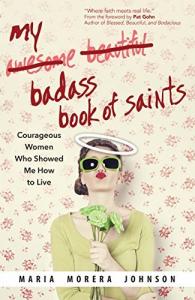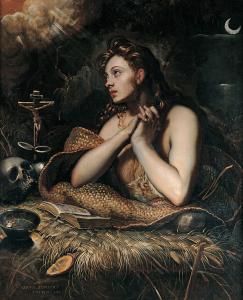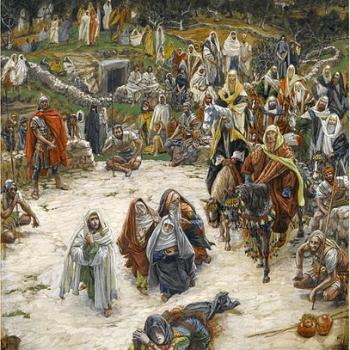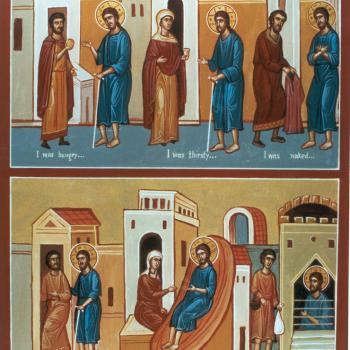When I wrote my blog, post entitled 12 Catholics I Admire, someone commented
Looking forward to part 2 — where you name Catholic women you admire.
So in response here are 12 Great Catholic Women Writers. Correction. 18 Great Women Writers. I am expanding it from my usual 12 to 18. You may like some writers and not others. You may think I should have added so and so and excluded that writer I don’t like. All I can say is that I have added whom I have added. All good examples of great women writers in my humble opinion. I don’t have much to add to what they are saying, so I’ll just let them speak for themselves. The title of this post comes from two sources. The First part is from this book.

Words: My long-suffering mother knows this about me. She calls me tremenda, a Spanish word that has many layers of meaning. To look at it, you might think it translates handily as tremendous, but that’s not quite right. It does mean tremendous, sometimes. It also means terrific, and terrible. It translates as bold. Daring. Fearless. Stalwart. Smart. Courageous. In a lot of cases, it can be used as a modifier to express both judge-y disdain and profound admiration. But mostly it means badass. The sensibilities for the word are a little looser in Spanish, but as a lover of words, I can’t help but be drawn to the nuances inherent in using a word that carries a little shock value.
Maria Morera Johnson, My Badass Book of Saints (2015) Ave Maria Press
The second part is from a saintly pope.
Progress usually tends to be measured according to the criteria of science and technology. Nor from this point of view has the contribution of women been negligible. Even so, this is not the only measure of progress, nor in fact is it the principal one. Much more important is the social and ethical dimension, which deals with human relations and spiritual values. In this area, which often develops in an inconspicuous way beginning with the daily relationships between people, especially within the family, society certainly owes much to the “genius of women.
Thank you, every woman, for the simple fact of being a woman! Through the insight which is so much a part of your womanhood you enrich the world’s understanding and help to make human relations more honest and authentic.
St. Pope John Paul II– Letter to Women (June 29. 1995)
This article is posted on the feast day of St. Mary Magdalene.

If you have done much historical reading, Biblical or otherwise, the lion’s share of accounting belongs to the voices of men. It would stand to reason that John would have described one of the disciples, someone who had been with Jesus as a part of the Twelve, as the one calling out the name “Rabbouni.” Instead, both Matthew and John recount Mary Magdalene as the herald of Good News. Mary Magdalene, traditionally thought of as the one out of whom demons had been called. Mary Magdalene, the one with a reputation. The one who lavishly anointed Jesus at table. The mind reels. And yet, with a slew of reasons for the surrounding community to doubt her audacious proclamation, the empty tomb and Christ’s self-revelation confirmed her words to be true! The earth quaked, and the status quo was about to be turned on its head.
Katie Cassady, On Saint Mary Magdalene (May 25, 2020) Blessed is She
And here are the rest of the writers listed by topic.
Assumption of Mary
I took a class in anatomy and physiology. As marvelous as it was to learn about how “wonderfully and fearfully” we are made — what with blood cells forming and fading, and bones and tissue becoming oxygenated and cleansed via blood and breath — nothing presented in the class coaxed an audible reaction from me until we studied the process of microchimerism.
Every pregnancy, brought to delivery or not, leaves a small amount of its own cells within the body of the mother — and those cells remain within her forever.
A small amount of Christ Jesus’ cells remained within Mary, for the whole of her life. Where we Catholics have a limited experience of Christ’s flesh commingling within our own upon reception of the holy Eucharist, Mary was a true tabernacle within which the Divinity did continually reside.
Our Lady’s body, holding Christ within it, could not remain on earth; of course, it would have to join itself to Christ in the heavenly dimension.
Elizabeth Scalia, How Does Science Back Up a Theological Dogma? Like This: (August 14, 2016) The Anchoress
Empowering Experience of Catholic Womanhood
Am filming a video soon talking about how my protestant church I grew up in took the Bible verse “Women must be silent in the church” literally. I got reprimanded for teaching elementary school boys & for praying publicly. I was told by some people that if I majored in religion I could do nothing with that degree. NOT all churches in my denomination were like that, especially on the West Coast there was more equality. But during formative times of my life I endured this and it really wounded me. That being said, Catholicism has been this epic contrast. It has been the most shocking, empowering thing seeing all the ways women’s giftedness is used.
Lizzie Reezay on FaceBook (October 19, 2019)
Healing in Worship
When I, as an abuse survivor, encounter Jesus’s passion as I worship at Mass, I do so through the very same mental faculty through which I harbor the memories that are a source of my own passion. But whereas my passion is ongoing (for my memories of past trauma are always part of me, even if I am not bringing them to mind at a given moment), Jesus’s passion has come to a definitive end with his death and resurrection. And I likewise encounter Jesus’s death and resurrection at every Mass, dying with him and rising with him.
Thus, if in worship I encounter Jesus’s death and resurrection through my memory just as I encounter his passion through my memory, then my own memory cannot end with my own passion. It has to continue with my rebirth in Christ—the renewal that began with my own baptism and is intensified with each encounter with him, which will culminate one day in my own resurrection and divinization.
Dawn Eden Goldstein, S.Th.D., aka Dawn Eden ,Healing Through the Liturgy: Insights from Vatican II (January 27, 2020) The Dawn Patrol
Jesus and Fish
So far as I can tell, this seems to be the only place in the Gospels where Christ evidently provides food ex nihilo (Latin, “out of nothing”). The wine at Cana was transformed from water (John 2:7-9); the loaves and fish that prefigured the Eucharist were multiplied from those few donated by the crowd (John 6:5-11); the makings of the Last Supper, from which would come the Eucharist, were prepared by the disciples (Luke 22:7-8). Even the devil did not ask Jesus to provide himself food ex nihilo, only to change stones into bread (Matt. 4:2-4). Here though, after the Resurrection, Jesus does not feed the disciples with fish they have provided; he gives them fish that seems to have no earthly origin. It is one more sign of his divinity. In the centuries to come, the fish would become both a symbol of Christ and a code by which persecuted Christians knew they were among friends.
Michelle Arnold, Breakfast with the Lord (3/1/2013) Catholic Answers
Jesus and Robin Hood
I am beginning to wonder now if the story of Robin Hood actually helped me make sense of the story of Jesus Christ, or indeed simply brought it more deeply into perspective for me. Because Robin, in a most inverse way, was still living out the Gospel by filling the hungry with good things and sending the rich away empty and was laying down his life in the process.
Avellina Balestri, Growing Up with Disney’s “Robin Hood” (April 15, 2020) Longbows & Rosary Beads @ Patheos Catholic

Loving as a Gay Catholic
When I became Catholic, all the other Catholics I knew were straight. I didn’t know any other gay people who were willing to accept the Church’s sexual ethic. I didn’t even know of anybody like that. For all my talk of having a unified worldview, there seemed to be no place for me—and especially for my longing to love and serve other women—in the Church. I acted like being Catholic gave me all the answers, when in fact I wasn’t even sure how to ask the questions.
As a gay woman I have had to rediscover forgotten ways of love: Scriptural practices of lifelong same-sex love, for example, like the covenant between David and Jonathan or the promises made by Ruth to Naomi.
Both Scripture and Christian history offer examples of people whose love of another man or another woman was intense, devoted, and chaste; self-giving, life-shaping; passionate, sacrificial, and beautiful.
Eve Tushnet, Your Weirdness is Welcome Here: Letter from Eve Tushnet (April 24, 2019) thecatholicwoman.com
Miracles
I remember looking at the clock as I closed my eyes. It was 9:15 AM, December 9, 1970. The only prayer I said was “Jesus please help me.” At that moment, I felt a hand touch my head and thought it was the priest who had come over to me. I opened my eyes and no one was there, but there was a power going though my body.
I looked down. My fingers had been stiff, but not deformed like my feet. There had been sores on my elbows. I looked at myself. My fingers were limber, the sores were gone and I could see my feet, in sandals, were no longer deformed.
Since that day, I have never had arthritis and have been completely free of pain. That was the miraculous healing, but my inner life saw the greatest change…
Briege McKenna, Miracles Do Happen: God Can Do the Impossible (1987,2002)
Mission
The mission the lord gives me is to help souls run after the Beloved and to make them a sanctuary in which he dwells and finds rest…. I want to give him souls that will love him with fervor so that he can rest in them; and once inflamed with his fire, they will go through the world in search of the lost sheep so that all may come to the feet of the God Shepherd.
Venerable Mother Mary Magdalene of Jesus in the Eucharist, C.P. (Taken from the Meditation of the day for Wednesday 22nd, 2020.
Motherhood
Motherhood is a blue collar job. I don’t care what style of dress or skirt you’re wearing, there is no way to be modest while dealing efficiently with the routine emergencies that normal children engender – children who, as a normal mode of expression, flail their limbs around like some kind of oversized, malevolent eggbeater, right at your hemline. Today, I had to lunge halfway across the room to rescue my toddler, who had launched herself from an armchair at a glass gerbil tank. I was able to lunge without pausing to consider whether my movements were graceful and feminine; and I didn’t worry, while lunging, about flashing the men in the room. Pants.
Simcha Fisher, Pants: A Manifesto – COMMENTS CLOSED (September 13, 2010) I have to sit down.

Ordinary Life
No matter how much excitement any of us has managed to squeeze in, for most of us, the vast majority of our lives is secretly mundane, even dull. But Jesus came to share the entirety of our lives, not just the parts that are memorable because they stand out against the backdrop of the ordinary. We are saved not only by the miracles of Galilee or the cross of Calvary, but by the familiarity of Nazareth.
Jaymie Stuart Wolfe, The Savior’s Secret Life (January 9, 2015) The Pilot
The Problem of Evil & Miracles
The problem of evil has always seemed to me to be the price we pay for having an intelligible world, one that we can investigate, understand, and love. If miracles were to be possible, they would have to stay below some threshold level of frequency so that they remained clear exceptions to the general course of causality instead of undoing the rule entirely.
Leah Libresco, Arriving at Amen: Seven Catholic Prayers That Even I Can Offer (2015) Ave Maria Press
On Being an Atheist
If everything that we call heroism and glory, and all the significance of all great human achievements, can be reduced to some neurons firing in the human brain, then it’s all destined to be extinguished at death. And considering that the entire span of homo sapiens’ existence on earth
wouldn’t even amount to a blip on the radar screen of a 5-billion-year-old universe, it seemed silly to pretend like the 60-odd-year life of some random organism on one of trillions of planets was something special. (I was a blast at parties.)
After her conversion from Atheism, she now comments
On Becoming Catholic
I found that the rules of the Church, that I had once perceived to be a set of confining laws, were rules of love; they defined the boundaries between what is love and what is not. It had changed me, my life, and my marriage for the better. I may not have experienced God, but, by following the teachings of the Church that was supposedly founded by him, I had experienced real love.
Jennifer Fulwiler, An Atheist Haunted by God: My Conversion to Catholicism (Feb 16, 2015) Aleteia
On Being a Nun
People have many misconceptions about what living in a convent is like. One assumption people have is that religious sisters are so much easier to get along with than other people, (because a habit must be some kind of magical, automatic saint cloak). We put it on and BAM, we’ve got a saint on our hands.
I wish.
But unfortunately, religious life is not some kind of magic silver bullet to sanctity. The convent is a saint-making factory, and all of us are in various stages of completion.
Sr. Theresa Aletheia Noble Jesus and the Secret to Dealing With Difficult People (February 2, 2016) Pursued by Truth @ Patheos Catholic

On Writing
I’ve been writing since I was a kid. One Lent, when my eldest two were toddlers and I had left the military to be a stay-at-home-mom, I got really mad at a book I was reading because I knew I could do better. So I gave up reading for Lent and took up writing. I’ve been writing ever since. (Of course, I also returned to reading!)
Karina Fabian Meet Karina Fabian, sci-fi author (APRIL 27, 2020) /thekoalamom.com/
A Woman’s Body
The feast of Mary Theotokos should be an occasion for women to ponder what it means that a human woman, one of us, was chosen to bear in her body the Second Person of the Trinity. But with the celebration of Mary as the Mother of God we see the female body, and all its powers, and hidden processes, and impure fluids, as something holy. Our giving birth is not just a passing-through, but a giving forth. Jesus took his earthly substance from his mother’s body, carried her genetics, probably resembled her. His body was born of her body. Looking at Mary as Mother of God perhaps provides us with a way of seeing mothering itself, the female body itself, as a living ikon of God-bearing.
Rebecca Bratten Weiss, the feast of the theotokos, and the theology of the female body (January 2, 2017) suspended in her jar @ Patheos Catholic
I’ll end this with the most womanly woman I know… My wife,
As a Catholic woman I have made a vow to be with my husband come what may until death do us part. No matter what my husband and I are Catholic together for the rest of our Earthly lives. It is a part of what defines me. As a wife I am to treat my husband with love, and he to treat me with love as well. Two became one on our wedding day over ten years ago.
Mark, my best friend told me he wanted to marry me and help me get to Heaven. I guess that makes it my vocation to help guide him there as well. Marriage is not just a vow, it is a Sacrament. It is also a life long vocation based on our love of God and one another.
Before my love of my husband Mark comes the love of God. This love though gets intertwined with those I love, most especially my Husband. As I stated the two of us have become one. I am so blessed to have a husband who loves me and forgives me, as I love and forgive him. Our arguments and disagreements never last long. If I’m honest they do exist though. We are two imperfect human beings.
We work together to help one another grow in holiness. That is the highlight of our marriage. That is the joy of being a married Catholic woman.
I love you Mark!
Kristin Wilson O.C.D.S.


















